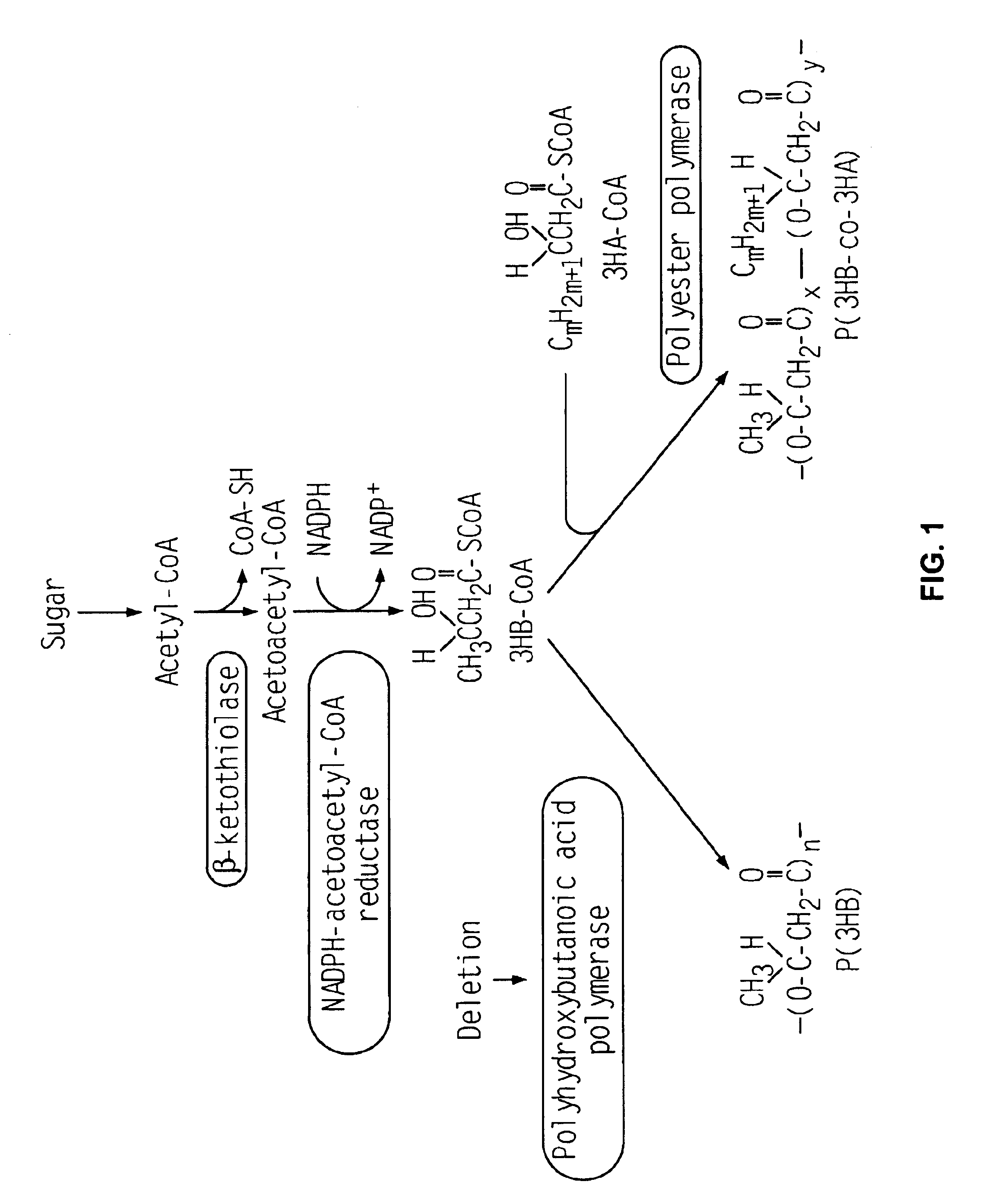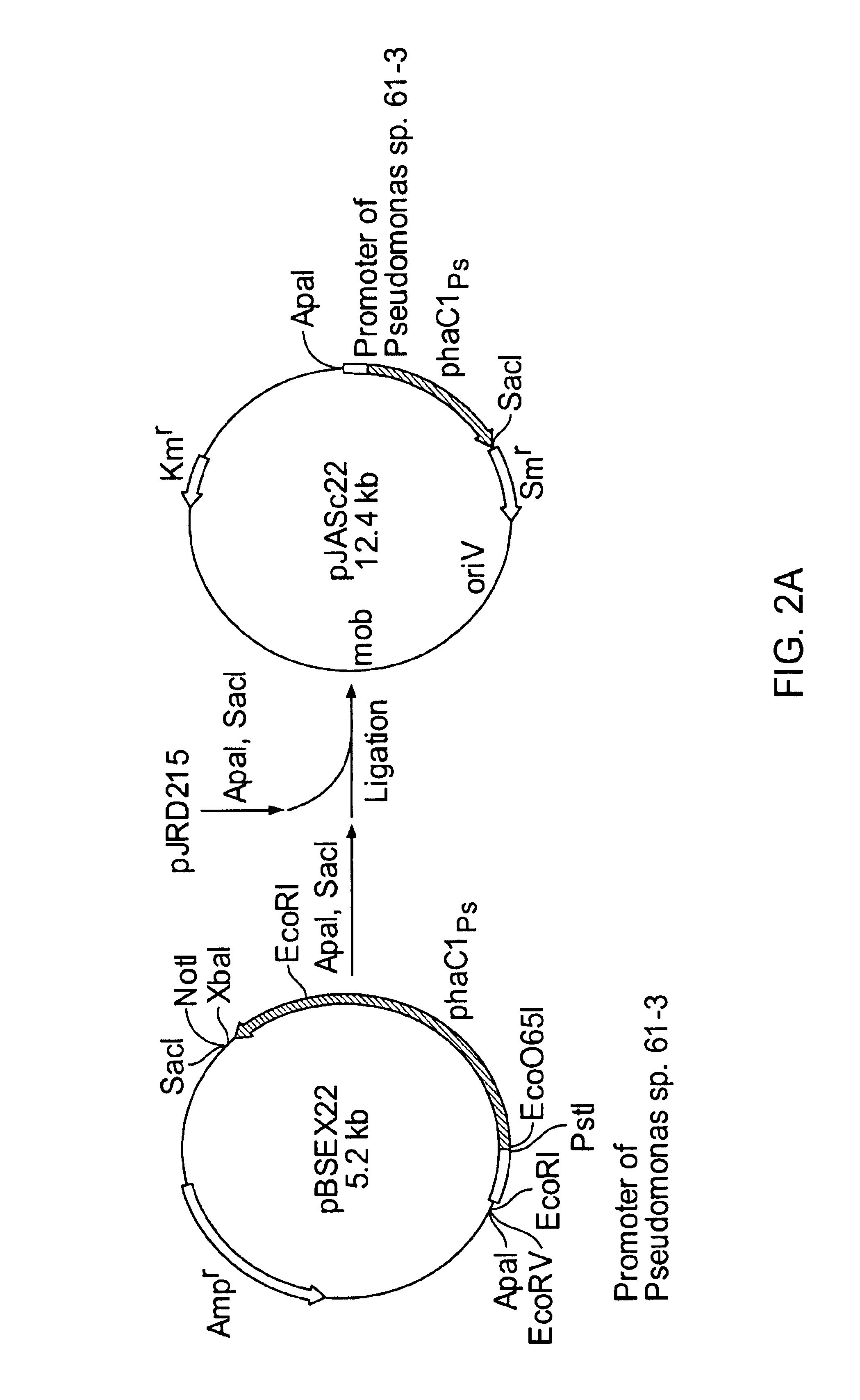Method of producing copolymer polyester
a copolymer polyester and polyester technology, applied in the direction of enzymology, organic chemistry, transferases, etc., can solve the problems of preventing the commercialization of p(3hb), poor impact resistance of p(3hb), and preventing the production of p(3hb)
- Summary
- Abstract
- Description
- Claims
- Application Information
AI Technical Summary
Problems solved by technology
Method used
Image
Examples
example 1
Establishment of a Polyhydroxybutanoic Acid Polymerase Gene-disruptant of Pseudomonas sp. Strain 61-3
Pseudomonas sp. strain 61-3 (JCM 10015) contains polyhydroxybutanoic acid polymerase (PhbC) in addition to polyhydroxyalkanoic acid polymerase (PhaC1 and PhaC2) that can use a broad range of substrates with a carbon number of 4 to 12. Therefore, this strain 61-3 synthesizes a blend of polyester (P(3HB)) having a sole unit of 3-hydroxybutanoic acid and copolymer polyester (P(3HB-co-3HA)) containing 3HA units with a carbon number of 4 to 12. A 3HB unit is often favored in comparison to PhaC1 or PhaC2 as a substrate by PhbC, which has a high affinity with the 3HB unit, so that copolymer polyester with a high 3HB molar composition is not synthesized. Accordingly, a polyhydroxybutanoic acid polymerase gene-disruptant of Pseudomonas sp. strain 61-3 was established.
First, the 5' terminal region of 342 bp and the 3' terminal region of 418 bp were deleted from a gene phbC.sub.Ps gene) encodin...
example 2
Construction of a Recombinant Vector
FIG. 2 shows steps to construct a recombinant vector. Cleavage and ligation of DNA fragments were performed according to standard techniques (Sambrook et al.: Molecular Cloning, A Laboratory Manual 2.sup.nd ed., Cold Spring Harbor Laboratory Press, 1989). As shown in FIG. 2, pBSEX22 and pGEM'-phbCAB were used as start plasmids. Here, pBSEX22 was constructed by inserting a 2.2-kb EcoRI-XbaI region containing phaC1 gene of Pseudomonas sp. strain 61-3 into pBluescript II KS+. pGEM'-phbCAB was constructed by amplifying phbCAB gene of Ralstonia eutropha H16 (ATCC 17699) (J. Biol. Chem., 264, 15293-15297, 1989; J. Biol. Chem., 264, 15298-15303, 1989) by PCR and inserting the resulting PCR fragment into a pGEM-T (Promega) vector having disrupted NdeI and PstI sites.
At the final step of the construction of a recombinant vector, the DNA fragment encoding a gene of interest was inserted and ligated into a plasmid pJRD215 (ATCC37533) capable of replicating w...
example 3
Construction of a Pseudomonas sp. Strain 61-3 (phbC::tet) Transformant
A transformant was constructed by introducing the plasmid obtained in Example 2 into the phbC.sub.Ps gene-disruptant phbC::tet) of Pseudomonas sp. strain 61-3 obtained in Example 1 by the conjugation transfer method. That is, four types of plasmids pJASc22, pJBB49-phb, pJKSc46-pha, and pJKSc54-phab were separately transformed into E.coli strain S 17-1 by the calcium chloride method. Next, the obtained transformants and Pseudomonas sp. strain 61-3 (phbC::tet) were separately cultured overnight in 1.5 ml of LB medium at 37.degree. C. and 28.degree. C., respectively. Subsequently, 0.1 ml of the culture product of E.coli and 0.1 ml of that of Pseudomonas sp. strain 61-3(phbC::tet) were mixed and cultured for 4 hours at 28.degree. C. After culturing, the mixture was plated over MS agar media (0.9% sodium diphosphate, 0.15% monopotassium phosphate, 0.05% ammonium chloride, 2% glucose, 0.1% (v / v) Trace element solution (...
PUM
| Property | Measurement | Unit |
|---|---|---|
| Fraction | aaaaa | aaaaa |
| Fraction | aaaaa | aaaaa |
| Fraction | aaaaa | aaaaa |
Abstract
Description
Claims
Application Information
 Login to View More
Login to View More - R&D
- Intellectual Property
- Life Sciences
- Materials
- Tech Scout
- Unparalleled Data Quality
- Higher Quality Content
- 60% Fewer Hallucinations
Browse by: Latest US Patents, China's latest patents, Technical Efficacy Thesaurus, Application Domain, Technology Topic, Popular Technical Reports.
© 2025 PatSnap. All rights reserved.Legal|Privacy policy|Modern Slavery Act Transparency Statement|Sitemap|About US| Contact US: help@patsnap.com



